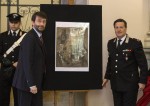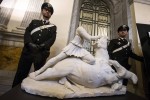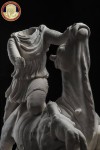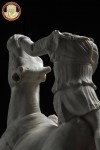 The Carabinieri art theft squad has recovered two major artworks in separate investigations: an early Cubist work by Pablo Picasso and an ancient Roman sculptural group of Mithras slaying the bull, a scene known today as a tauroctony. Only one of them, the sculpture, is known to have been looted. The Picasso painting is currently under investigation, but its purported provenance is a classic art smuggler’s tall tale, and a particularly bold iteration at that. It could be true, sure, but the Carabinieri clearly don’t think so or they wouldn’t have confiscated it.
The Carabinieri art theft squad has recovered two major artworks in separate investigations: an early Cubist work by Pablo Picasso and an ancient Roman sculptural group of Mithras slaying the bull, a scene known today as a tauroctony. Only one of them, the sculpture, is known to have been looted. The Picasso painting is currently under investigation, but its purported provenance is a classic art smuggler’s tall tale, and a particularly bold iteration at that. It could be true, sure, but the Carabinieri clearly don’t think so or they wouldn’t have confiscated it.
The Picasso came to light when Sotheby’s, in the name of the putative current owner, filed an export license request in Venice for the oil painting Violin and Bottle of Bass made in 1912 by Pablo Picasso. The painting is listed in the 1961 edition of the great multi-volume catalogue raisonné of the artist’s works compiled by Christian Zervos. It was done in the early Analytic Cubist style developed by Picasso and Georges Braque characterized by a palette of browns and other neutrals and as such is extremely rare and desirable.
Yet, the declared value of this early work was 1.4 million euros ($1.5 million). That’s a ridiculously lowball figure for a painting that would go for at least 15 million euros ($16.2 million) in the open market and could easily make more at auction. The weirdly cheap Picasso drew the unblinking eye of art squad investigators who sought an explanation from the owner. Said owner turns out to be a retired Roman frame maker. In 1978, a gentleman of advanced age came to his shop holding a picture frame with a photo of his beloved late wife inside. The maid had apparently knocked over the frame and broken the glass, devastating the widower. The frame maker repaired the frame for free because it was such an easy fix. In gratitude, the customer repaid the frame maker by returning two days later with a gift: Violin and Bottle of Bass. The frame maker had no idea what a treasure he’d been given for replacing a two-cent piece of glass, so he just stashed it somewhere and forgot about it for 36 years until discovering by accident that he might have a Picasso.
Mysteries abound in this less than entirely believable story. Tests have confirmed the attribution of the painting to Picasso, but more will be forthcoming while the investigation proceeds.
 The statue of Mithras is a looter’s special, too. The Carabinieri found it during a complex operation of surveillance centered in the Fiumicino area outside Rome where the airport is, a crossroads of the market in illicit archaeological goods. Carabinieri noticed a nondescript van with no external identifiers that for some reason had a motorized escort — a motorcycle in front and a Smart Car taking up the rear. They pulled the van over and searched it. The back was filled with flowers and plants under a tarp. Cops saw the nose of a bull sticking up through the plants and found the marble sculpture group with the soil from its illegal excavation still caked on it.
The statue of Mithras is a looter’s special, too. The Carabinieri found it during a complex operation of surveillance centered in the Fiumicino area outside Rome where the airport is, a crossroads of the market in illicit archaeological goods. Carabinieri noticed a nondescript van with no external identifiers that for some reason had a motorized escort — a motorcycle in front and a Smart Car taking up the rear. They pulled the van over and searched it. The back was filled with flowers and plants under a tarp. Cops saw the nose of a bull sticking up through the plants and found the marble sculpture group with the soil from its illegal excavation still caked on it.
 The sculpture dates from the 2nd-3rd century A.D. and depicts an iconic scene in Mithraism wherein the hero tilts back the bull’s head and slays the beast with a knife while a dog and snake lick its blood and a scorpion has a go at the bull’s testicles. Every Mithraeum had at least one representation of this scene, usually reliefs and frescoes. A large freestanding sculpture like this would have been extremely luxurious then, and it is even more so today. Experts put its value at a minimum of 8 million euros. Only two other large tauroctonies like this one are known to exist today, one in the British Museum, one in the Vatican Museums.
The sculpture dates from the 2nd-3rd century A.D. and depicts an iconic scene in Mithraism wherein the hero tilts back the bull’s head and slays the beast with a knife while a dog and snake lick its blood and a scorpion has a go at the bull’s testicles. Every Mithraeum had at least one representation of this scene, usually reliefs and frescoes. A large freestanding sculpture like this would have been extremely luxurious then, and it is even more so today. Experts put its value at a minimum of 8 million euros. Only two other large tauroctonies like this one are known to exist today, one in the British Museum, one in the Vatican Museums.
 Soil tests of the dirt on the sculpture pinpointed two possible locations of origin in central Italy: the ancient Etruscan cities of Tarquinia and Vulci. The regional Culture Ministry immediately began emergency excavations at the possible sites and found the exact spot from which the statue had been looted. It was Tarquinia, and archaeologists found two smoking guns in the form of the little rampant dog missing from the sculpture and the head of the missing snake. They also unearthed a few other marble fragments, the remains of a mosaic floor and a terracotta tile floor that suggest this was once a Mithraem.
Soil tests of the dirt on the sculpture pinpointed two possible locations of origin in central Italy: the ancient Etruscan cities of Tarquinia and Vulci. The regional Culture Ministry immediately began emergency excavations at the possible sites and found the exact spot from which the statue had been looted. It was Tarquinia, and archaeologists found two smoking guns in the form of the little rampant dog missing from the sculpture and the head of the missing snake. They also unearthed a few other marble fragments, the remains of a mosaic floor and a terracotta tile floor that suggest this was once a Mithraem.
A map of Switzerland and Swiss traveling routes found in the van make it very clear where the tauroctony was headed if it hadn’t been intercepted. Its value on the open market would be something in the neighborhood of 8 million euros ($8.7 million), a meager thing compared to its immense historical value. The statue will go on temporary display at the Vatican Museums in a few weeks after which it will return to Tarquinia in July.
 The Carabinieri announced a third recovery at the same press conference, an 18th century oil painting by Luca Carlevarijs entitled View of Piazza San Marco from the Dock. It was stolen on April 28th, 1984, from the home of a private collector and discovered last September in the hands of an art dealer in Milan indicted for receiving stolen goods and illegal export of a painting now in the United States. While searching the dealer’s home, cops found 190 photographs of paintings. One of them was the Carlevarijs. They compared the photos against the squad’s database of stolen cultural goods and discovered the 30-year-old theft. It seems the artwork had been given to the dealer by a collector in anticipation of its sale.
The Carabinieri announced a third recovery at the same press conference, an 18th century oil painting by Luca Carlevarijs entitled View of Piazza San Marco from the Dock. It was stolen on April 28th, 1984, from the home of a private collector and discovered last September in the hands of an art dealer in Milan indicted for receiving stolen goods and illegal export of a painting now in the United States. While searching the dealer’s home, cops found 190 photographs of paintings. One of them was the Carlevarijs. They compared the photos against the squad’s database of stolen cultural goods and discovered the 30-year-old theft. It seems the artwork had been given to the dealer by a collector in anticipation of its sale.
Carlevarijs was the founder of the Venetian school of vedute, meaning views or landscapes of the city, starting with etchings in 1703 and then moving on to oil paintings. Canaletto was strongly influenced by him, as you can see in this piece, and probably met Carlevarijs around 1720 when the young artist moved back home to Venice after studying in Rome. Canaletto may have been Carlevarijs’ pupil at this time — the sources are murky — but if so, he soon surpassed the master. In 1725, just five years after Canaletto’s return, art merchant Alessandro Marchesini would suggest to his client, collector Stefano Conti who was looking for vedute of Venice, that he acquire a piece by Canaletto who “inevitably amazes everyone here who sees his works, which are in the manner of Carlevaris, but light shines out from the sun.”
 Compared to the Picasso and the tauroctony I’m afraid poor Mr. Carlevarijs doesn’t quite make the headline, but it amuses me how each of these stories touches on the standard tropes of the traffic in illicit art and antiquities. We’ve got a supershady provenance story, a recently excavated, high-quality ancient sculpture that was destined for surreptitious sale in Switzerland where it doubtless would have received brand new papers certifying it as having been in “an anonymous Swiss collection” for the past 50 years, and we have the art dealer acting as a fence and keeping a big cache of incriminating photographs of the pieces he is trying to sell/has sold illegally. It’s like looter’s bingo.
Compared to the Picasso and the tauroctony I’m afraid poor Mr. Carlevarijs doesn’t quite make the headline, but it amuses me how each of these stories touches on the standard tropes of the traffic in illicit art and antiquities. We’ve got a supershady provenance story, a recently excavated, high-quality ancient sculpture that was destined for surreptitious sale in Switzerland where it doubtless would have received brand new papers certifying it as having been in “an anonymous Swiss collection” for the past 50 years, and we have the art dealer acting as a fence and keeping a big cache of incriminating photographs of the pieces he is trying to sell/has sold illegally. It’s like looter’s bingo.